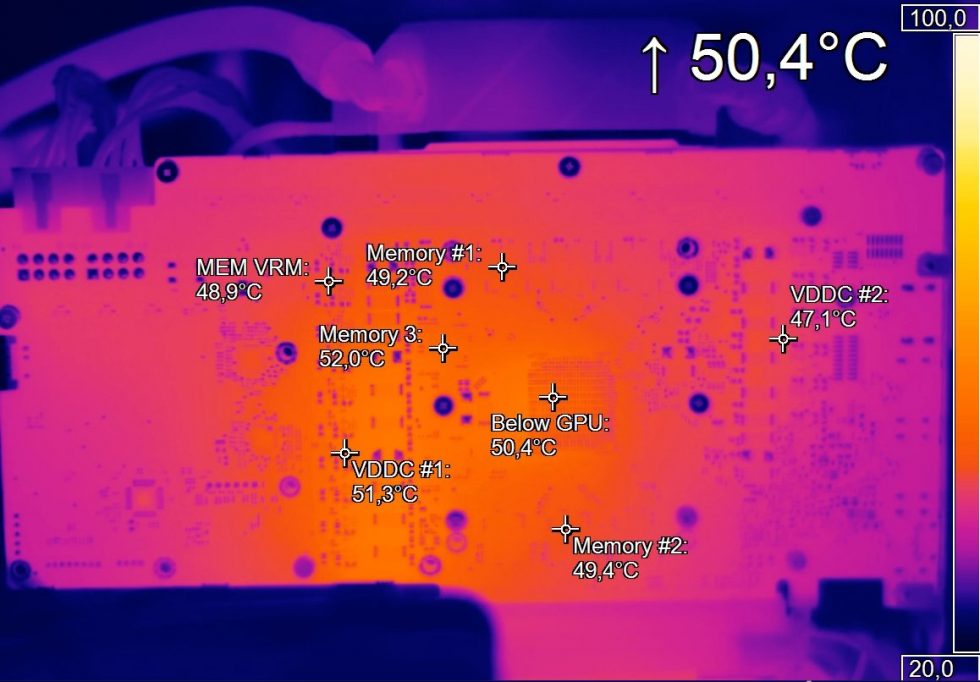I measure at a total of six points on the back of the board, which have previously been prepared with calibrated measuring lacquer (“tropicalization”) and counter-tested again with control sensors. An Optris PI640 is used together with the required software on a monitoring PC. Besides the radiometric videos for internal use, I take screenshots of the measurements at the appropriate places. Interestingly, the values below the BGA don’t correspond exactly to the GPU diode inside and at Furmark the board is heated up even more by the voltage converters. Also important: the power consumption remains the same in both scenarios, which also means that the GPU temperature remains almost the same except for a degree or two difference, thanks to the Power Limit.
The fans spin up to just over 2000 rpm without intervention, which is completely pointless. Because from about 1500 rpm the revs don’t matter at all, it just doesn’t get any cooler. This is a huge difference compared to the previous models and clearly also a step in the right direction. Especially since the static pressure at 1000 to 1500 rpm is still quite sufficient to control the slim radiator. The rest is regulated by the throughput, which can be varied in the selected two stages. Depending on Gusto and OC.
Measurement at 1500 rpm
This is already much quieter and still offers full performance! And it cools really well and no worse than what was installed on the Toxic from Sapphire. Just quieter, whether it’s game or stress. The GPU itself reports 50 °C at 350 watts in gaming (picture below) and 52 °C in Furmark. Nothing is left to luck here, and probably won’t burn up. The memory returns 52 °C (gaming) in the sensor and 54 °C in Furmark, which also roughly corresponds to the board measurement of the warmed up card.
If you reduce the TDP to the specified 300 watts, then everything is a bit cooler. You can live well with the GPU edge temperature of 47 to 48 °C, the memory is only slightly below the previous value at 51.4 °C in the maximum.
However, the quite audible just under 37 dBA are quite ok for the TDP and quieter than what the Toxic produces with about 1 dBA more. What is pleasing, however, is the rather rushing and not hummable sound of the new fans and the complete lack of annoying pump noise.
Measurement at 1100 rpm
The cooling performance at 300 watts is really acceptable and you would have surely managed the 350 watts even below 55 °C GPU edge with a compromise at 1250 rpm. The GPU itself reports 53 °C at 300 watts, the memory is at about 55 °C as a sensor value. You can leave it at that.
But even now you can’t hear the pump, compliments! Is the system even on? Whisper quiet, because I only measure just under 30 dB(A).
Conclusion and summary
Finally, let’s move on to the overall verdict. The cooling performance is good to very good, especially the almost silent pump can please. The build quality is also on a very high level and the modularity fits into the positive picture as well as the decent overall impression of all components. Visually, as always, it’s all a matter of taste, but it doesn’t look so much like a cheap AiO as it does a decent watercooler. All parts, from the cooling block to the radiator are full copper and taken from the normal water cooling range. You notice that in the end, because most of it is really rock solid and fits together beautifully (as if by accident).
If you can live with the design, you’ll get a quite sophisticated and potent cooling system, which doesn’t go beyond the scope of the current usual AiO solutions with the targeted 244.99 RRP Euro, because you’ll get real custom loop technology and no aluminum-saturated mass products, whose lifespan is hard to estimate. Let’s put it this way: it falls into the category “you can buy it if you’re tired of air” and still don’t trust yourself with a complete water cooling system made of single parts in your PC.
Whereby one could even do this, if one hangs still another CPU water block (or better the new polar bear) with in the system and sets immediately still another radiator. Because this is also very easy thanks to the quick-release fasteners. A plus for this solution, without question. And the availability will also be fixed. Launch is the 29.04.2021 and I can at least brag that I own a self-made solution that anticipates the launch. Because the parts are the same and better fingers gibts at Alphacool certainly not only cleaner. Because thermal paste can be cruel.







































54 Antworten
Kommentar
Lade neue Kommentare
Veteran
Urgestein
Mitglied
Urgestein
1
Veteran
Mitglied
Veteran
1
Mitglied
Urgestein
Veteran
Mitglied
1
Mitglied
Veteran
Mitglied
Mitglied
Mitglied
Alle Kommentare lesen unter igor´sLAB Community →